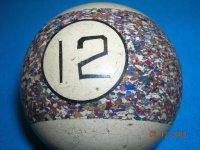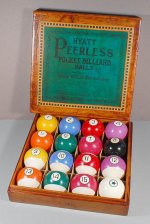You are using an out of date browser. It may not display this or other websites correctly.
You should upgrade or use an alternative browser.
You should upgrade or use an alternative browser.
Vintage Balls
- Thread starter stlerdave
- Start date
Do you have any pictures that you could post?Who is the most knowledgable when it comes to vintage pool balls. I have came across some and need help, and this is the best site for experts.
Hunger Strike also knows a thing or two re balls.
I second that. Hunger Strike
The ball at the top might be ivory but I can't tell with the blur.
The small black diamond is a break ball which I think might get $30.
The rest look to be a standard clay set. If you could complete it and there is not much cracking, you might get $150 or so for it. If you only have the 8 shown, you might get $3-5 each on Ebay.
The small black diamond is a break ball which I think might get $30.
The rest look to be a standard clay set. If you could complete it and there is not much cracking, you might get $150 or so for it. If you only have the 8 shown, you might get $3-5 each on Ebay.
Ivory has a grain pattern and a nerve canal. The grain pattern is symmetrical around the nerve canal (which is like an axis going through the "poles"). Older ivory balls have a bunch of small cracks that follow the grain pattern with lots of concentric cracks around the nerve canal and very few around the "equator". The pattern is roughly what you would expect if the ball were made from the center of a tree limb.How can you id an ivory ball?
Also, if you touch the ball with a red-hot pin, you will get a burning hair smell, but that's not something you would want to do to a good ivory ball. In a related test, miscues smell different with ivory balls. Yes, you can tell by the smell of a miscue.
I am by no means an expert but I have owned quite a few sets of antique balls.
This is what I see...
Top picture is a bakelite or phenolic cue ball that is simply cracked.
Second pictured white ball looks to be clay
The brown balls are Bakelite break balls made by Hyatt
The numbered set looks like a set I had that was confirmed to be a clay "Fancy O" set made by Hyatt
None of what I see is Ivory.
Diameters of each ball would help.
I hope this helps.
Lee
This is what I see...
Top picture is a bakelite or phenolic cue ball that is simply cracked.
Second pictured white ball looks to be clay
The brown balls are Bakelite break balls made by Hyatt
The numbered set looks like a set I had that was confirmed to be a clay "Fancy O" set made by Hyatt
None of what I see is Ivory.
Diameters of each ball would help.
I hope this helps.
Lee
Thank you for enlightening us Mr. Jewett.
Ivory has a grain pattern and a nerve canal. The grain pattern is symmetrical around the nerve canal (which is like an axis going through the "poles"). Older ivory balls have a bunch of small cracks that follow the grain pattern with lots of concentric cracks around the nerve canal and very few around the "equator". The pattern is roughly what you would expect if the ball were made from the center of a tree limb.
Also, if you touch the ball with a red-hot pin, you will get a burning hair smell, but that's not something you would want to do to a good ivory ball. In a related test, miscues smell different with ivory balls. Yes, you can tell by the smell of a miscue.
You've never smelled my miscue! :kma:
I've seen a few antique Misc balls here and there at antique stores for like $2.00 i'm guessing these are just crap balls? which numbered sets, what do you look for? Whats the "GOOD FIND"?
Watch on Ebay for what sells for a high price. There are a few plastic balls that can get good money (like the US Bicentennial commemorative set from Albany, mint in the box) but mostly you'll be looking for clay balls with non-standard designs. Like the set that has hexagonal eyes. Or ivory balls.I've seen a few antique Misc balls here and there at antique stores for like $2.00 i'm guessing these are just crap balls? which numbered sets, what do you look for? Whats the "GOOD FIND"?
I've seen a few antique Misc balls here and there at antique stores for like $2.00 i'm guessing these are just crap balls? which numbered sets, what do you look for? Whats the "GOOD FIND"?
To me a "good find" is a ball that is interesting. It could be new, old, clay, plastic or an elephants tooth. As long as I want it in my collection then it is a good find.
I found this in a Nebraska antique store for $6 and have never seen another one like it, I am sure others know more about it but its remains a mystery to me.






